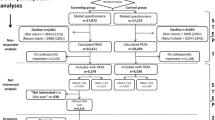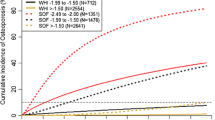Abstract
Poor compliance may be detrimental to the effectiveness of a screening programme if those at greatest risk of the disease do not attend. Therefore we undertook a study to test whether non-attenders to a screening programme for low bone density, a risk factor for osteoporosis, were at a differential risk of low bone density compared with attenders. Seven hundred and eighty-nine women aged 45–49 years living within 32 km of Aberdeen were selected at random from the Community Health Index and invited to attend for screening for low bone density as a risk of factor for osteoporosis. Attenders and non-attenders were surveyed regarding their risk factors for osteoporosis. Non-attenders were significantly heavier than attenders. In addition, 6 non-attenders who subsequently chose to attend had significantly higher body weight and bone mineral density, at Ward's triangle, than initial attenders. Non-attenders to a screening service for bone density may be at lower risk of developing osteoporosis. Non-attendance, therefore, would not be detrimental to the cost-effectiveness of a screening service for bone density. However, this study indicates there is a potential for response bias in studies of bone density and osteoporosis.
Similar content being viewed by others
References
Waller D, Agass M, Mant D, Coulter A, Fuller A, Jones L. Health checks in general practice: another example of inverse care? BMJ 1990;300:1115–8.
Heilbrun LK, Ross PD, Wasnich RD, Yano K, Vogel JM. Characteristics of respondents and nonrespondents in a prospective study of osteoporosis. J Clin Epidemiol 1991;44:233–9.
de Waard F, Collette HJA, Rombach JJ, Baanders-van Halewijn EA, Honing C. The DOM project for the early detection of breast cancer, Utrecht, The Netherlands. J Chron Dis 1984;37:1–44.
Sonne-Holm S, Sorenson TIA, Jensen G, Schnohr P. Influence of fatness, intelligence, education and sociodemographic factors on response rate in a health survey. J Epidemiol Community Health 1989;43:369–74.
Simons LA, Simons J. How ‘representative’ are subjects attending a coronary risk factor screening programme? Aust NZ J Med 1984;14:35–8.
Aloia JF, Cohn SH, Vaswani A, Yeh JK, Yuen K, Ellis K. Risk factors for postmenopausal osteoporosis. Am J Med 1985;78:95–100.
Hemenway D, Colditz GA, Willett WC, Stampfer MJ, Speizer FE. Fractures and lifestyle: effect of cigarette smoking, alochol intake and relative weight on the risk of hip and forearm fractures in middle-aged women. Am J Public Health 1988;78:1554–8.
Daniell HW. Osteoporosis of the slender smoker: vertebral compression fractures and loss of metacarpal cortex in relation to postmenopausal cigarette smoking and lack of obesity. Arch Intern Med 1976;136:298–304.
Williams AR, Weiss NS, Ure CL, Ballard J, Dating JR. Effect of weight, smoking, and estrogen use on the risk of hip and forearm fractures in postmenopausal women. Obstet Gynecol 1982;60:695–9.
Stevenson JC, Lees B, Devenport M, Cust MP, Ganger KF. Determinants of bone density in normal women: risk factors for future osteoporosis? BMJ 1989;298:924–8.
Slemenda CW, Sui L, Hui PH, Longcope C, Wellman H, Johnston CC. Predictors of bone mass in perimenopausal women: a prospective study of clinical data using photon absorptiometry. Ann Intern Med 1990;112:96–101.
Falch JA, Sandvik L, Van Berensteijn ECH. Development of an index to predict early postmenopausal bone loss. Bone 1992;13:337–41.
Garton MJ, Torgerson DJ, Donaldson C, Russell IT, Reid DM. Recruitment methods for screening programmes: trial of a new method within a regional osteoporosis study. BMJ 1992;305:82–5.
Scotland A. Towards readability and style. Community Med 1985;7:126–32.
Bland JM, Altman DG. Statistical methods for assessing agreement between two methods of measurement. Lancet 1986;1:307–10.
Melton LJ, Wahner HW, Richelson LS, O'Fallon WM, Riggs BL. Osteoporosis and the risk of hip fracture. Am J Epidemiol 1986;124:254–61.
Adams JE, Whitehouse RW, Stilman A, Adams PH, Kay C. Bone mineral density reference ranges across populations: In: Ring EFJ, editor. Current research in osteoporosis and bone mineral measurement II. London: British Institute of Radiology, 1992: 14.
Palta M, Prineas RJ, Berman R, Hannan P. Comparison of self-reported and measured height and weight. Am J Epidemiol 1982;115:223–30.
Stewart AL. The reliability and validity of self-reported weight and height. J Chron Dis 1982;35:295–309.
Stewart AW, Jackson RT, Ford MA, Beaglehole R. Underestimation of relative weight by use of self-reported height and weight. Am J Epidemiol 1987;125:122–7.
Sheldon TA, Freemantle N, Ibbotson S, Pollock C, Mason J, Long AF. Population screening for osteoporosis to prevent fractures. Quality in Health Care 1992;1:77–80.
Torgerson DJ, Donaldson C. Why compliance: an economic view of high compliance as a screening objective. BMJ (in press).
Author information
Authors and Affiliations
Rights and permissions
About this article
Cite this article
Torgerson, D.J., Donaldson, C., Garton, M.J. et al. Population screening for low bone mineral density: Do non-attenders have a lower risk of osteoporosis?. Osteoporosis Int 4, 149–153 (1994). https://doi.org/10.1007/BF01623061
Received:
Accepted:
Issue Date:
DOI: https://doi.org/10.1007/BF01623061




